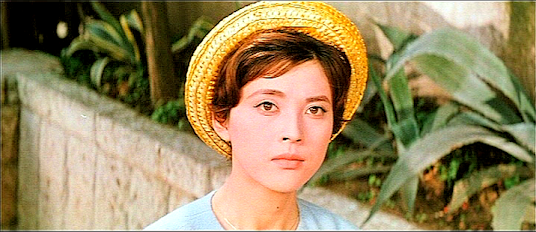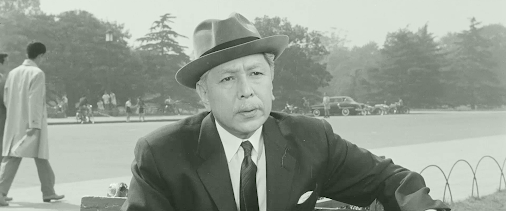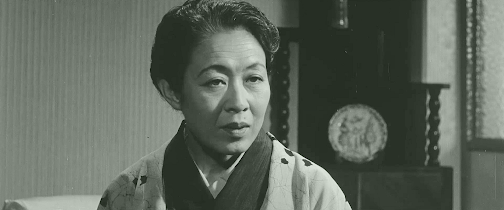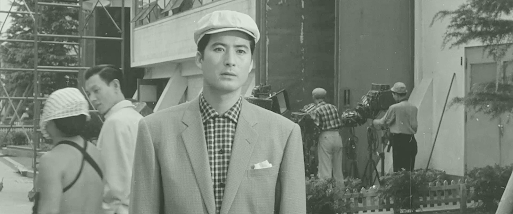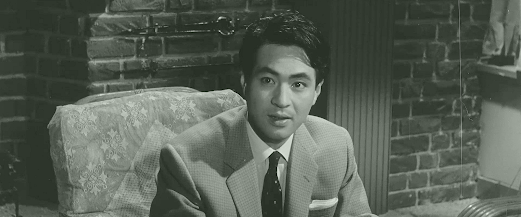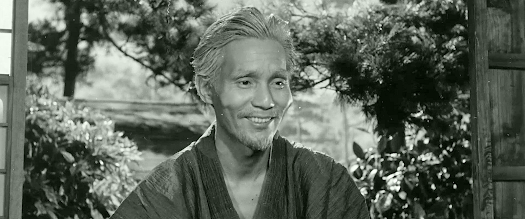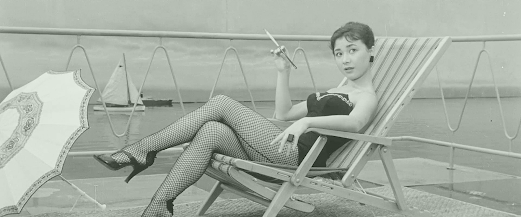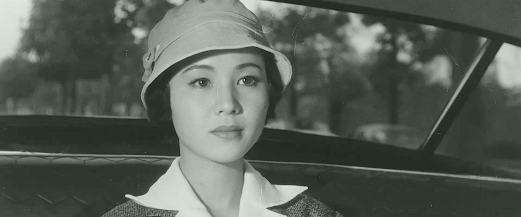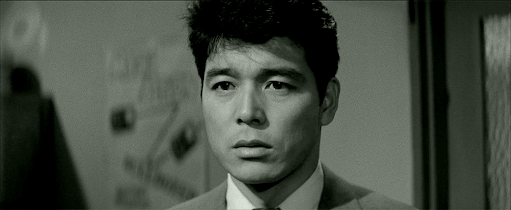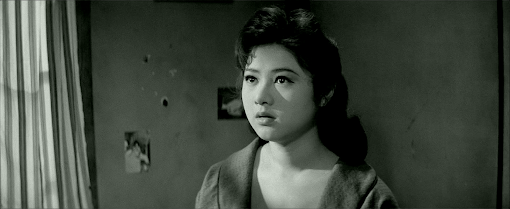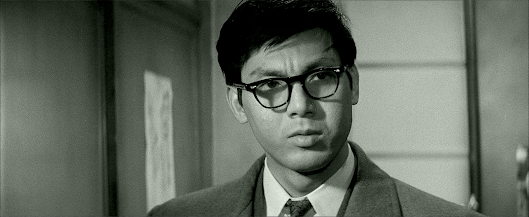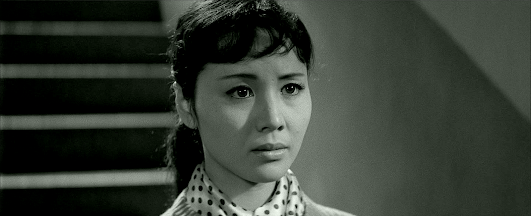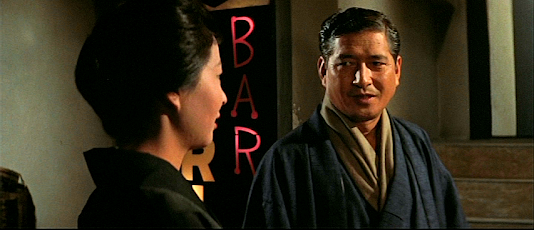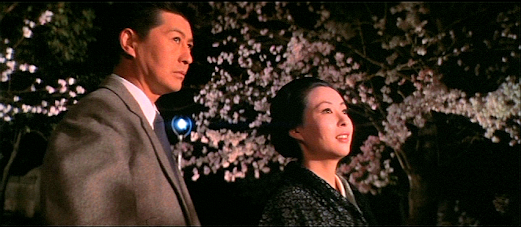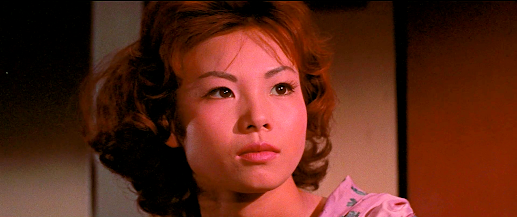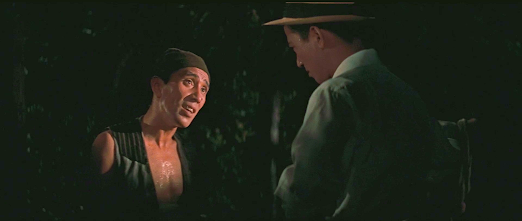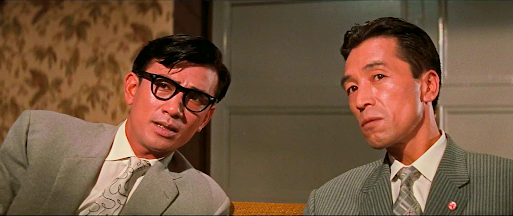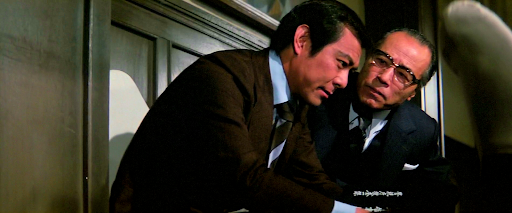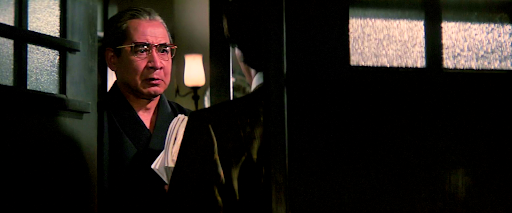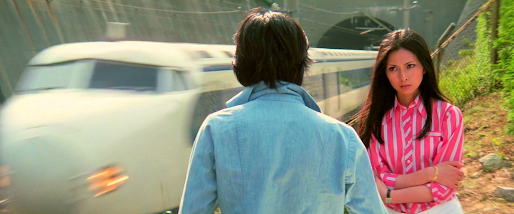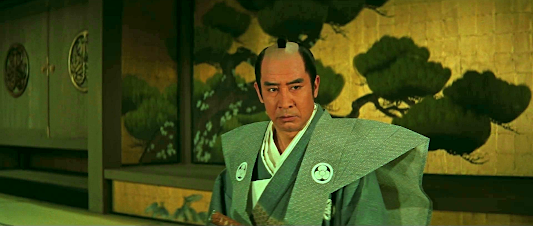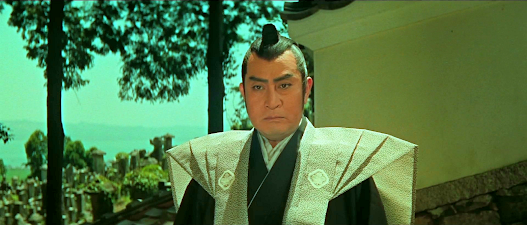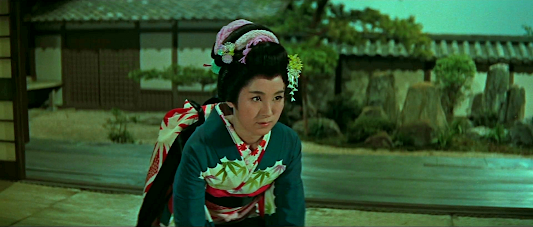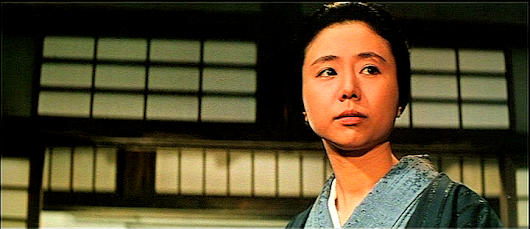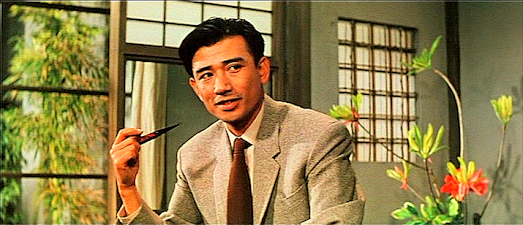M.R. Dowsing's Blog, page 3
July 9, 2025
Gyakukosen / 逆光線 / (‘Backlight’, 1956)
Obscure Japanese Film #199
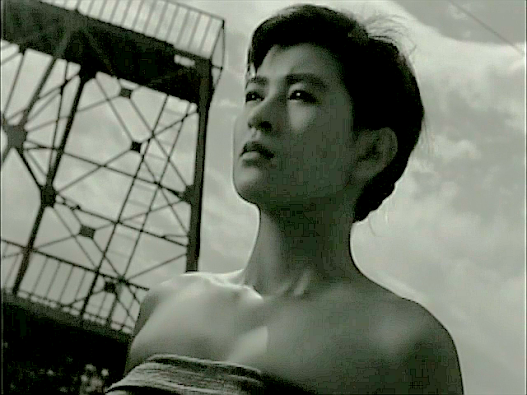 Mie Kitahara
Mie KitaharaFollowing on from the commercial success earlier in 1956 of theirfilms Season of the Sun and Crazed Fruit, this was Nikkatsu’s stabat a female-centred ‘sun tribe’ movie - ‘sun tribe’ being a term adopted by theJapanese press in reference to the first film to describe what was then a newphenomenon: rebellious, spoilt teenagers, generally from wealthy families, whodespised the older generation and were unapologetically interested only in gratifyingtheir own desires. Like Season of the Sun,this one was directed by Takumi Furukawa, a lesser director than Ko Nakahira,who had made Crazed Fruit, the femalestar of which was Mie Kitahara, who stars again here.
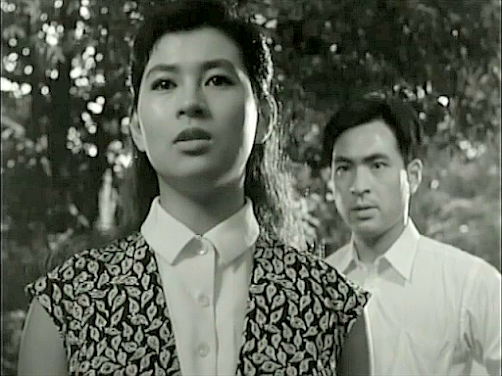 Kitahara and Shoji Yasui
Kitahara and Shoji YasuiKitahara plays Reiko, a student who shares a dormitory with otherfemale students and who, in this case, does not seem to be from a wealthyfamily or even to have a family – certainly no reference is made to one, andshe has to take on various part-time jobs to get by. What marks Reiko out asdifferent is her attitude to sex – she likes to take the initiative and, earlyon in the film, she makes advances to a male student, Maki (ShojiYasui), literally throwing herself at him and biting the button off his jacket.The two begin having a relationship, but one in which traditional roles arereversed – in this case, it’s the man who wants marriage and complains that sheonly loves him for his body, while she wants no commitment, only to have a goodtime. Reiko also has a one-night stand with Teramura (Kyoji Aoyama), incurringthe wrath of his fiancé / her classmate Motoko (Misako Watanabe) as a result.But it’s when she begins tutoring a young boy at his home and seduces hisfather (Hiroshi Nihonyanagi) that she really begins playing with fire…
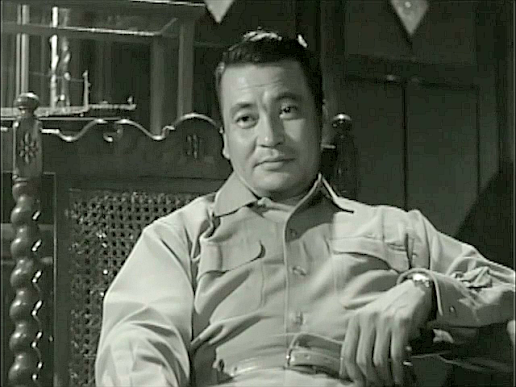 Hiroshi Nihonyanagi
Hiroshi NihonyanagiWhereas the previous two films had been based on stories byShintaro Ishihara, the source for Gyakukosen was a novel of the same name by Kunie Iwahashi (1934-2014).Apparently, on its publication (also in 1956), there was ‘a frenzy of mediacoverage of her as the female equivalent of Ishihara’ (Japanese Wikipedia).
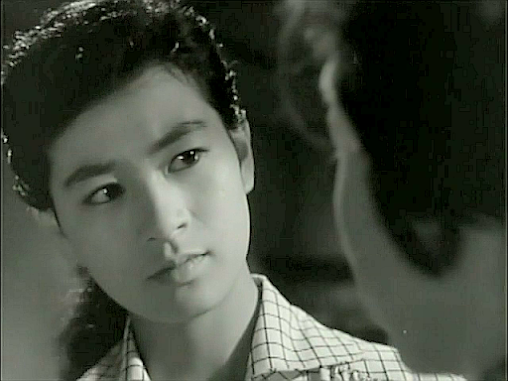
Although it may seem like fairly tame stuff today, there’s nodoubt that the sexual frankness of this film and the carefully-calculated momentsof uninhibited sensuality on Reiko’s part (another example being the scene inwhich she takes a drink of water from Teramura’s mouth at a drinking fountain)would have been quite shocking at the time. The problem with the film is thatit comes across less as a heartfelt plea for sexual equality and more like a cynicallymotivated product designed to stir up controversy and extract as many yen aspossible from the pockets of Japanese teenagers. The sun tribe genre proved tobe extremely short-lived as there was some evidence that a number of rapes andsexual assaults had been committed by youngsters influenced by the films. Thisled to protests by concerned parents and teachers, who were successful inhaving the genre effectively banned by the end of the year. As Liam Grealy andCatherine Driscoll point out in an online article, there were really only fivesun tribe films proper, all of which were released in 1956, the other two beingKon Ichikawa’s Punishment Room andHiromichi Horikawa’s Summer in Eclipse.
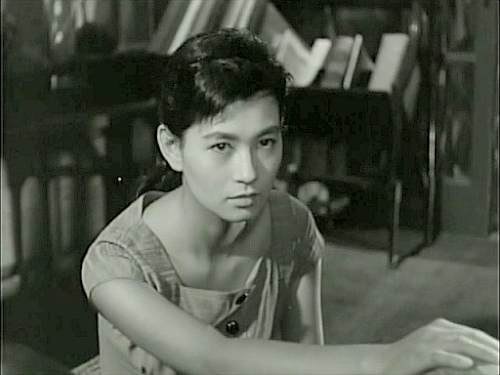
One oddity of this film is that it features a greatdeal of group singing of Russian folk songs by the young people, presumably areflection of the fact that communism had become popular in Japan during thepost-war years and had inspired an interest in Russian culture. Gyakukosen is largely unremarkable in terms of cinematiccraft – the ending is really the only part that is visually memorable – and probablyonly of interest to fans of Mie Kitahara or anyone with an interest in the suntribe phenomenon.
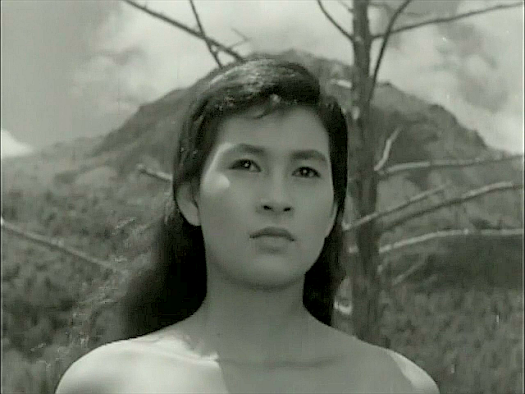
July 1, 2025
Snow Country / 雪国 / Yukiguni (1965)
Obscure Japanese Film #198

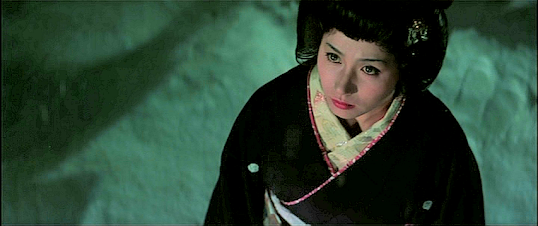 Shima Iwashita
Shima IwashitaYasunari Kawabata’s novel SnowCountry began to appear in fragmented chapters in 1935, but was notpublished in its final form until 1948. Set in the mid-1930s at a hot springresort somewhere in the mountains in the west of Japan’s main island, Honshu,it concerns Shimamura, a writer who rather absurdly writes about Westerndancing despite never having witnessed a performance. A married man and fatherwith a certain amount of independent wealth, he’s an idler who travels to theresort alone and meets Komako, a young woman whose company the innkeeper arrangesas all of the town’s geisha are already booked for a big party. The two are quicklyattracted to one another – Komako fallsfor him a little too hard, although Shimamura is more reserved and has nointention of leaving his wife. Still, after returning home from his trip, hefinds himself unable to forget Komako and returns to see her on two furtheroccasions, by which time she has become a full-fledged geisha. Shimamura alsobecomes interested in Yoko, a young woman with whom Komako has an uneasy relationshipdue to their mutual connection to Yukio, a young man dying of tuberculosis whohad been Komako’s childhood friend, possibly fiancée, and is now being caredfor by Yoko…
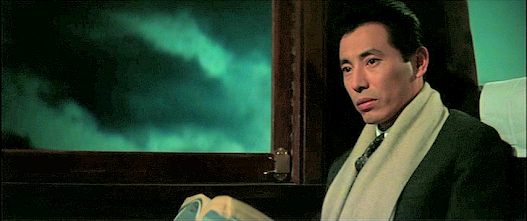 Isao Kimura
Isao KimuraSnow Country was first filmed in 1957 by director Shiro Toyoda for Toho withKeiko Kishi as Komako, Ryo Ikebe as Shimamura and Kaoru Yachigusa as Yoko. ThisShochiku version directed by Hideo Oba a mere eight years later is by no meansa carbon copy. Most obviously, whereas the earlier film was shot in academyratio black and white and ran 143 minutes, this film is in colour andwidescreen and (mercifully) runs 21 minutes shorter. Oba’s reputation isconsiderably less distinguished than Toyoda’s – probably rightly so – but insome respects his film does manage to improve on the previous one.
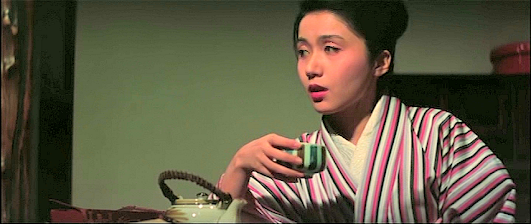
As played by Keiko Kishi, Komako came across as childish,over-emotional and actually quite annoying, her mood changing by the minute,whereas Shima Iwashita somehow manages to avoid the pitfalls of playingKawabata’s heroine, making her appeal for Shimamura much more understandable(although why she should be drawn to him so much is less clear). The musicis also an improvement – there was way too much of it in Toyoda’s film, and thequality was also poor, but Naozumi Yamamoto’s superior score is used moresparingly and effectively even if it is occasionally on the syrupy side.
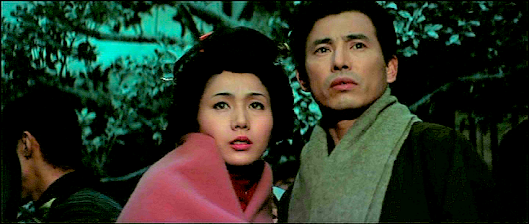
On the other hand, as Shimamura, Isao Kimura (a respected actorbut not a big star), lacks Ryo Ikebe’s charisma and makes little impression,while Toyoda’s snowscapes were more visually arresting even without the benefitof colour and widescreen. The underwritten character of Yoko is a thanklessrole in both films, but I felt that Kaoru Yachigusa managed it better thanMariko Kaga does here. Incidentally, Chieko Naniwa – who played the head maidin the earlier picture – somehow managed to get herself cast again here, thistime playing the blind masseur.
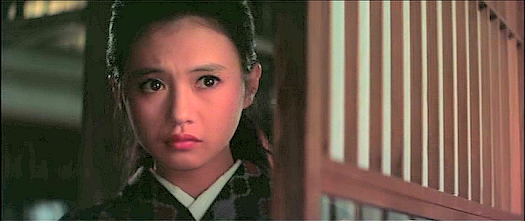 Mariko Kaga
Mariko KagaLike the novel, Toyoda began his film with Shimamura’s secondvisit before flashing back to the first, while Oba has opted for a chronologicaltimeline and also added a little narration from Shimamura which works well. Toyodahad found it more convenient to make Shimamura a painter, while Oba retains thecharacter’s occupation as described by Kawabata, but adds a scene withShimamura’s wife (played by Kaneko Iwasaki), who is only spoken about in boththe book and the first film. One aspect that both films have in common is toresolve some of the ambiguity of the novel, in which it’s never really clearwhether Shimamura and Komako sleep together or whether Yoko survives theclimactic fire – both filmmakers strongly imply that the relationship is consummatedand clarify the fate of Yoko. The two films both have their strengths andweaknesses and it will be a matter of personal opinion which one is preferred,but in my view Kawabata’s famous work is not terribly well-suited to filmadaptation.
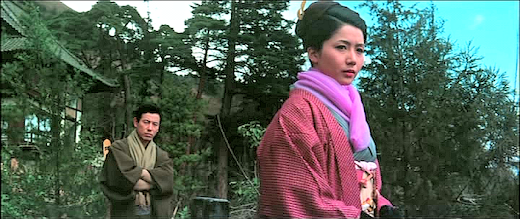
In regard to Hideo Oba, a director best-known for his What’s Your Name? trilogy (1953-54), butstill obscure to most, I suspect that his previously-reviewed film The Invisible Wall (1958) was a randomassignment that did not especially interest him, whereas this was a project he atleast put his heart into even if it’s no masterpiece. Like the other four filmsI’ve seen by him, it’s well made but not particularly inspired, original orindividual. It was his sixtieth film out of the 64 he would direct and hisfinal screenplay credit out of 14, as well as his fourthof five films with star Shima Iwashita, and it’s fans of Iwashita who arelikely to find this film most rewarding.
Unfortunately, thecolour photography did not look its best on the rather low-res copy I watched.

DVD at Amazon Japan (no English subtitles)
June 28, 2025
Sisters / 姉妹 / Kyodai (1955)
Obscure Japanese Film #197
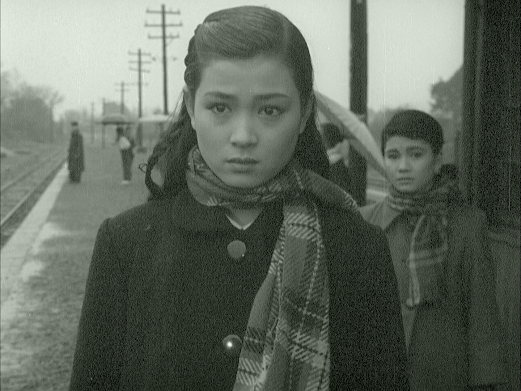 Hitomi Nozoe and Hitomi Nakahara
Hitomi Nozoe and Hitomi NakaharaKeiko (Hitomi Nozoe) and Toshiko (Hitomi Nakahara) are teenagedsisters whose family home is in the mountains close to a hydroelectric damwhere their father (Akitake Kono) works. Their three younger brothers stay athome with their mother (Hiroko Kawasaki), but Keiko and Toshiko attend schoolin the city, so during term time they stay with aunt Otami (Yuko Mochizuki) anduncle Ginzaburo (Jun Tatara). Therelations get on well together, but Ginzaburo is prone to drinking, gamblingand cavorting with geisha and Otami sometimes has to hide from creditors. Atleast Ginzaburo is preferable to their other uncle (Taiji Tonoyama), who beatshis wife (Setsuko Shinobu).
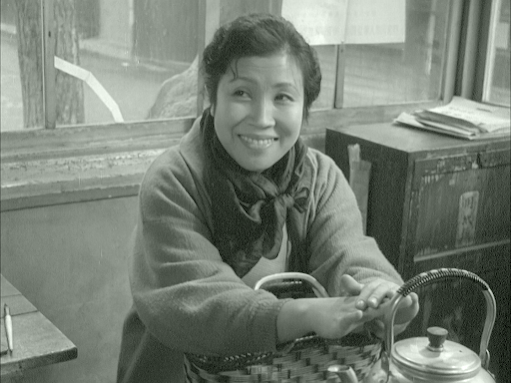 Yuko Mochizuki
Yuko MochizukiAs Keiko’s parents cannot afford to send her to university, they’realready looking for a match for her though she’s only 17. She likes powerstation worker Oka (Taketoshi Naito) despite his strange passion for driedsquid, but his prospects are poor. The more tomboyish Toshiko is only 14 but alreadyhas a strong individualistic streak and equally strong opinions. Although thetwo girls are like chalk and cheese, they’re also unusually close, but seemfated to part sooner or later…
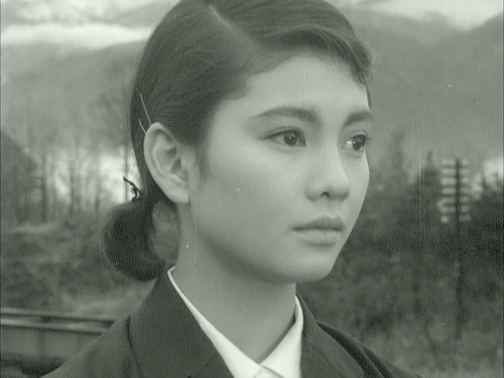 Hitomi Nakahara
Hitomi NakaharaShot mostly on location, this character-driven piece produced bythe independent company Chuo Eiga has little plot, but plenty of comedy andtragedy in equal measure. Chuo Eiga was something of a haven for leftistfilmmakers unable to get their projects accepted by the major studios. Sisters touches on some typicalsocialist concerns, such as the lay-offs of power station workers, but for themost part wears its politics lightly. The source was a semi-autobiographical1954 novel by Fumi Kuroyanagi (1912-65), for whom the younger sister, Toshiko,was something of an alter ego. Perhaps for largely practical reasons, thesetting has been changed from pre-war Niseko in Hokkaido to post-war Matsumotoin Nagano Prefecture.
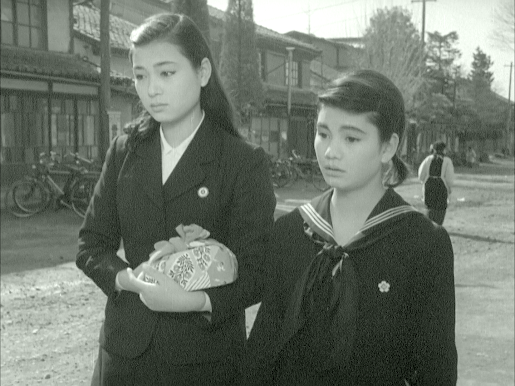
Director Miyoji Ieki (who also co-wrote the screenplay with KanetoShindo) was known for his films focusing on the difficulties faced by youngpeople growing up, and Sisters istypical of his work. Although largely forgotten these days, there’s no doubtthat Ieki qualifies as a true auteur due to the consistency of his theme andfrequent input in the writing of his pictures. As usual, he elicits fineperformances out of his young principals, although it should be noted thatHitomi Nakahara (also featured prominently in Ieki’s All My Children), who plays a 14-year-old most convincingly, wasactually 19 at the time and, ironically, one year older than her namesake,Hitomi Nozoe, who plays her older sister. Ieki may not have been the moststylish of directors, but like his films Stepbrothers(1957), All My Children (1963) andThe Wayside Pebble (1964), this is anintelligent, sensitive and genuinely moving piece of work.
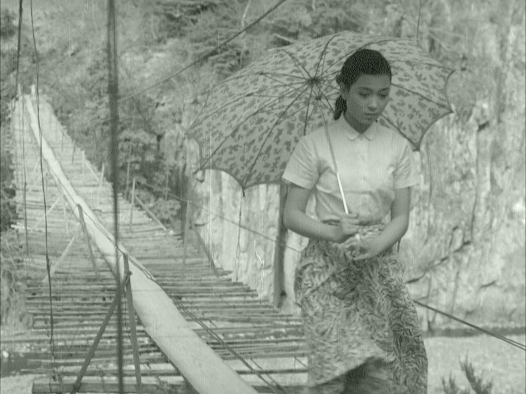
Thanks to A.K.
DVD at Amazon Japan (no English subtitles)
June 22, 2025
Mountain Pass / 峠 / Toge (1957)
Obscure Japanese Film #196
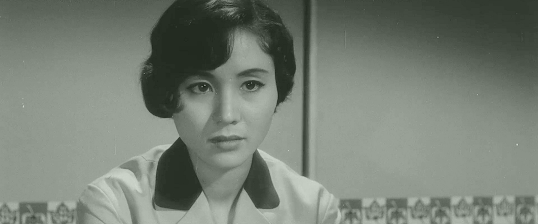 Yoko Minamida
Yoko Minamida
Tsukiko (YokoMinamida) is a young woman dabbling in acting who gets signed by a movie studiowhere she is cast alongside star actress Harumi Sada (Misako Watanabe), aselfish bitch. Tsukiko’s father, Reisuke (Masao Shimizu), is a distinguishedformer diplomat who now lives with Tsukiko’s stepmother, Tomiko (SachikoMurase), with whom she has an uneasy relationship, believing that Tomiko stoleReisuke away from her late mother.
Tsukiko keeps running into nice guy magazinereporter Daisuke (Ryoji Hayama), a friend of her twinkly-eyed uncle (JukichiUno). However, after she meets the wealthy and money-obsessed Junzo (ShojiYasui), who wants to marry her, she decides that the film biz is not for herand becomes his wife. Unfortunately, it turns out that Junzo and Harumi areformer lovers; when Harumi happens to be on the same train as the newlyweds,she asks them which hotel they’ll be staying at and then transfers to the sameone with the intention of seducing Junzo…
Despite itstitle, this romantic drama from Nikkatsu studios has little to do withmountains – there’s some talk about Daisuke finding a mole up a mountain, whichseems to be a strained metaphor for something or other, but that’s about it.Based on a serialised novel of the same name by Jiro Osaragi (best-known forhis series of novels featuring his hooded swordsman character, Kurama Tengu),it was adapted by one Tamio Aoyama, whose brief screenwriting career resultedin only nine credits. Frankly, on the evidence of this film, it’s not hard tosee why – there are more coincidentalmeetings (one of my pet hates!) than you can shake a stick at, most of thecharacters are mere types rather than recognisable human beings, and Tsukiko’smarriage to Junzo is entirely unconvincing.
The actors dotheir best, with Yoko Minamida and Sachiko Murase making especially heroicefforts with the flawed material they’ve been lumbered with, while MisakoWatanabe can hardly fail to make an impression in the fun bad girl role, butfor the most part these characters – especially the male ones – never reallycome to life. The corny string-dominated music score of Takanobu Saito and pedestriandirection by Buichi Saito (no relation) certainly do not help matters either.Director Saito had been an assistant to Ozu and began his own career makingfilms of a similar type to his mentor, but had little success until he switchedto more commercial fare such as TheRambling Guitarist (1959) and it’s eight sequels.
While the themeof how to deal with an unfaithful partner has potential and it’s satisfying tosee Tsukiko refuse to be a victim and stand up for herself at the end, Mountain Pass is too contrived to bejudged anything more than a mediocre piece of work.
Thanks to A.K.
Bonus trivia: ShoheiImamura was assistant director on this film and can be seen playing one of thestaff at the studio where Tsukiko makes her movie debut.
June 20, 2025
Wounded Beast / 傷つける野獣 / Kizu tsukeru yaju (1959)
Obscure Japanese Film #195

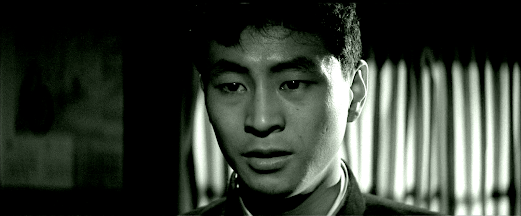 Tamio Kawaji
Tamio KawajiKasahara (Tamio Kawaji) is a youngman who bungles an attempt to rob a bank in Yokohama, shooting one of the staffin the process, and is forced to flee the scene without the loot. DetectiveKizaki (Hideaki Nitani) is assigned to the case and soon discovers that thebullet matches a gun stolen from a detective killed in Osakaa few days before. Kasahara seeks refuge in the house of his sister (TomokoKo), but the police soon arrive and he only just manages to give them the slip.
Kizaki’s investigations reveal that Kasahara was orphaned during the warand subsequently slid into a life of delinquency and petty crime. He loves Yoshiko(Hisako Tsukuba), who reciprocates his feelings, and we learn that he attemptedthe bank robbery after happening to see a vox pop interview in a cinemanewsreel in which Yoshiko was asked by a reporter what it was she most wantedand replied ‘Money!’ The police now realise that all theyhave to do is follow Yoshiko and Kasahara will turn up sooner or later…
This Nikkatsu noir credits notablefuture director Kei Kumai with its screenplay (his first) and has a separatecredit for the prolific Hajime Takaiwa for ‘adaptation’, although itseems not to have had a literary source. Director Hiroshi Noguchi* directed hisfirst eight feature films for Nikkatsu between 1939 and 1941, after which thewar led to the studio becoming part of Daiei until 1954, when Noguchi became adirector again, having spent most of the intervening years as an A.D. atShochiku. He never made the top tier and remained a B-picture man until hispremature death from a heart attack in 1967 at the age of 54, shortly after having completed his 85th film, Nikkatsu’s only monstermovie, Gappa, the Triphibian Monster.However, if Wounded Beast is anythingto go by, he was clearly not without talent, as it’s a fast-moving, stylish andentertaining piece of work.
The majority of the cast are notterribly well-known (at least outside Japan), but – as one of the detectives – it does feature a young Joe Shishido,who appears to have begun but not yet completed the cheek augmentation surgerythat would eventually lead to him resembling a hamster with the mumps. Theunderrated Yoko Minamida also pops up as Detective Kizaki’s girlfriend.
The opening credits sequence benefitsfrom a cool jazz theme by composer Teizo Matsumura featuring what sounds likemetal pipes being struck; this is followed by an abrupt silence and anattention-grabbing opening shot of a gun pointed directly at the camera. Noguchialso makes effective use of real locations and handles the action sequencesvery well. However, the most surprising aspect of the film is the amount ofsympathy it has for Kasahara, even though he’s killed two people, one of whom was a police detective. The film’s liberal message is clearly that he’s really just a scared kid who’s had a lousy life and is desperatelytrying to act tough because he lacked a positive role model.
*Aka Haruyasu Noguchi, real nameShigeichi Noguchi
Bonus trivia: Hisako Tsukuba laterproduced Piranha (1978) and severalof its sequels.
Watched with dodgysubtitles
June 15, 2025
Kaei / 花影 / (‘The Shade of Blossoms’, 1961)
Obscure Japanese Film #194
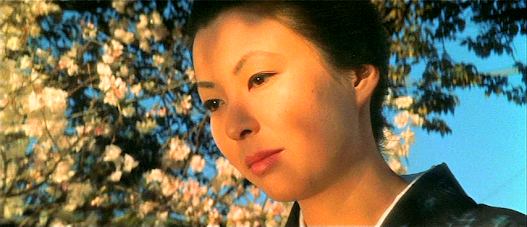 Junko Ikeuchi
Junko IkeuchiYoko (Junko Ikeuchi) isan ageing Ginza bar hostess who has never been sufficiently calculating to hooka wealthy patron and get herself set up with her own bar or restaurant. Seeinglittle future for herself, she plans to commit suicide with pills she’s beensaving up. As she prepares to do so, her story is told in flashback and welearn that she was adopted as a child and, as an adult, has had a series ofdisappointing relationships with a variety of men. These include universitylecturer Matsuzaki (Ryo Ikebe), middle-aged lawyer Hata (Tadao Takashima), youngTV producer Shimizu (Ichiro Arishima), and old-flame-made-good Nogata (TatsuyaMitsuhashi). However, the only one she’s ever really loved is older art criticTakashima (Shuji Sano), as he’s the only one who’s never made a pass at her,but perhaps she’s idealised him too much…
Based on aprize-winning novel of the same name by Shohei Ooka – best known for Fires on the Plain – the story of thisTokyo Eiga production (distributed by Toho) was inspired by the life of MutsukoSakamoto (1915-58), a Ginza bar hostess with whom Ooka had had aneight-year-long affair before she committed suicide. The adaptation by RyuzuKikushima (one of Kurosawa’s regular collaborators) is extremely faithful tothe book, which was translated into English as The Shade of Blossoms by Dennis Washburn and published in 1998 bythe University of Michigan Press (the title refers to the shade underblossoming cherry or plum trees). Both film and novel have an almost shockingly sadending without a trace of sentimentality, and director Yuzo Kawashima has donea fine job of bringing the story to life without imposing his own ego upon it.When he (or perhaps Kikushima) does add something – like Hata’s adopteddaughter killing a worm in the garden after her father has thoughtlesslypointed out to Yoko that she’s not his by blood – it’s entirely appropriate andhelps to illustrate the emotions of the characters.
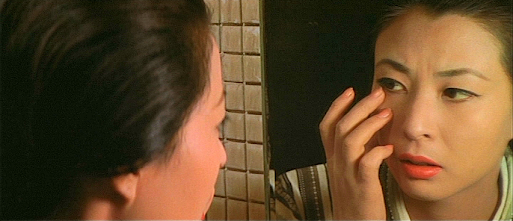
Yoko, a hostess who isweary of men, knows every seduction trick in the book only too well and seemsin danger of sliding into alcoholism, is 38 years old in the novel, and wouldhave been a perfect fit for Hideko Takamine, then 37. However, Tokyo Eiga wentwith the 28-year-old Junko Ikeuchi, whom they had just signed after herprevious studio Shintoho had gone bankrupt. Although she’s a little young forthe role, Ikeuchi could perhaps pass for a very well-preserved 38, but in anycase she gives an excellent performance and manages to put Yoko’s complexemotions across very well. The remainder of the cast are left fighting forscreen time as there are an unusually large number of important characters –indeed, it’s unusual to see Ryo Ikebe and Chikage Awashima in such small roles(Awashima plays the former mistress of Nogata’s deceased father). Sei Ikeno’sharpsichord-dominated score also adds a touch of class to the proceedings andnever tries to manipulate our emotions in an obvious way.
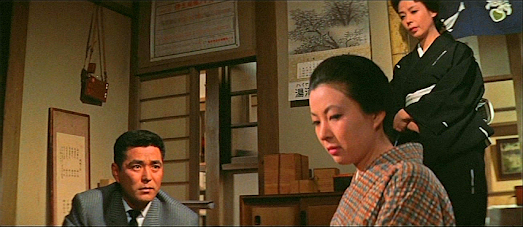 Tatsuya Mihashi, Ikeuchi and Chikage Awashima
Tatsuya Mihashi, Ikeuchi and Chikage Awashima
Shohei Ooka is on recordas saying that Yukio Mishima was effusive in his praise of the book and that, afterMishima’s suicide, he felt convinced that it was this theme of Yoko wanting toend her own life while she was still beautiful that had appealed to him somuch.
June 11, 2025
The Last Trump Card / 最後の切札 / Saigo no kirifuda (1960)
Obscure Japanese Film #193
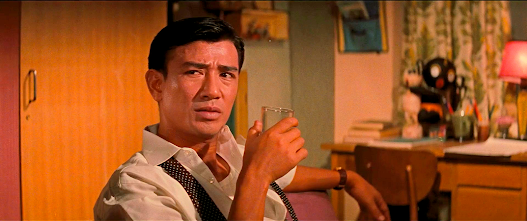 Keiji Sada
Keiji SadaTatsuno (Keiji Sada) isa clothing store owner who has an unusual side hustle – he pretends to be partof a ‘New Religion research group’ with his sidekick Yoshimura (Seiji Miyaguchi),and together they extort money from religious organisations by offering to savethem from potential scandals (mostly created by Tatsuno) for a price. In otherwords, they are blackmailers, and their only motivation seems to be greed. Asif this weren’t sleazy enough, Tatsuno also dabbles in a little pimping andprocuring on the side, and is having affairs with multiple women includingnightclub singer Sonoko (Miyuki Kuwano from TheShape of Night) and TV actress Tsuruko (Keiko Hibino), both of whom hetreats with contempt…
Based on a 1957 novel entitledNiku no boku (‘Servant of the Flesh’or ‘I am Flesh’) by Hideo Shirasaki (1920-92) and with a screenplay by Kurosawaregular Shinobu Hashimoto, this Shochiku production was directed by YoshitaroNomura, who had been an assistant to Kurosawa on Scandal (1950) and The Idiot(1951), and it features a whole host of character actors familiar from Kurosawapictures, including Miki Odagiri (the girl from Ikiru), Jerry Fujio, Seiji Miyaguchi, Eijiro Yanagi, Taiji Tonoyamaand Koji Mitsui. And just when you think Ko Nishimura’s not going to be in it,his macabre little face finally pops up to deliver the rather gruesome ending. However,in my view screenwriter Hashimoto sometimes produced sub-par work when not undert the guidance of a really great director like Kurosawa or Masaki Kobayashi, andhere he allows the story to become too talky and complicated (even when watched with pretty good subtitles) while forgettingto give us anyone to root for, resulting in a mostly unengaging movie.
Usually cast in nice guyroles, leading man Keiji Sada probably relished the opportunity to play acomplete scumbag for a change, something he would go on to do again in hisfinal film, Sweet Sweat (1964). Talkingof sweat, there’s also a lot of that in this movie, which is set in Tokyo duringa heatwave and has everyone dripping throughout. Director Yoshitaro Nomura –best known for his Seicho Matsumoto adaptations such as Castle of Sand (1974) – was a very good director, but this is notone of his best and I couldn’t help feeling it’s the sort of material thatwould have been better in black and white. For all its cynicism, at heart thisis a superficial film – if watching a nasty guy do nasty things for 90 minutesbefore getting his comeuppance is enough for you, you might enjoy it, but it’sreally got nothing to say. I doubt that it was a box office success, especiallyas it appears to be the only film adaptation of a Hideo Shirasaki novel and Japanesefilm companies tended to raid an author’s work repeatedly if they had made any moneyfrom it.
Alternative titles: TheGrave Tells All / The Cards Will Tell
Thanks to A.K.
June 7, 2025
Main Line to Terror / 動脈列島 / Domyaku retto (1975)
Obscure Japanese Film #192
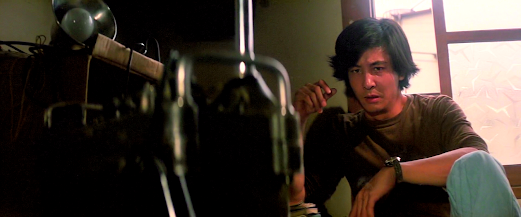 Masaomi Kondo
Masaomi Kondo
Akiyama (Masaomi Kondo)is a young doctor furious about the death of one of his patients, which hebelieves was the result of her living right next to a shinkansen (bullet train) track as the intense noise and vibrationbrought on memories of World War 2 air raids and induced repeated panic attackswhich wrecked her health. It’s been around a decade since the advent of thebullet train, and many other people living near to the lines have also sufferedgreatly, but the rail bosses have done little to address the problems, soAkiyama decides it’s time to take matters into his own hands. He persuades hisgirlfriend Tomoko (Keiko Takahashi), a nurse, to steal a phial ofnitro-glycerine from the hospital and uses it to create a bomb, threatening todestroy a bullet train in ten days’ time if Japanese National Railways (JNR)fail to address the issues immediately. The Police Commissioner (Eitaro Ozawa)calls in investigator Takigawa (Jiro Tamiya), who marshals all the forces athis disposal in a race against time to catch Akiyama and avert a majordisaster…
This Tokyo Eigaproduction has the type of story that can hardly fail to be gripping, but alsocalls attention to the issue of noise pollution from high-speed trains, whichwas something of a hot topic at the time. The film was based on a 1974 novel bythe leftist writer Ikko Shimizu (1931-2010) which won the Mystery Writers ofJapan Award. His work had a strong element of social commentary and often dealtwith themes such as corruption in big business, but was only occasionallyadapted for the big screen. In this case, the book was inspired by a lawsuitfiled against JNR by 575 residents of Nagoya City which would drag on for overa decade (the residents eventually received substantial compensation and theoriginal bullet trains were gradually replaced by quieter models). However, theidea of one of these protestors turning terrorist appears to have been Shimizu’sinvention. As the story makes JNR look pretty bad, it’s unsurprising that theyrefused to co-operate with the film company, so how certain scenes could havebeen pulled off without their help is anyone’s guess.
Co-written and directedby Yasuzo Masumura, by this time a freelancer after the collapse of Daiei, it’sefficiently made but one of the least characteristic of his works. The plot hasits implausibilities, but also a strong police procedural element and amemorable climax involving a bulldozer which made me wonder whether thefilmmakers had seen the previous year’s American TV movie Killdozer.
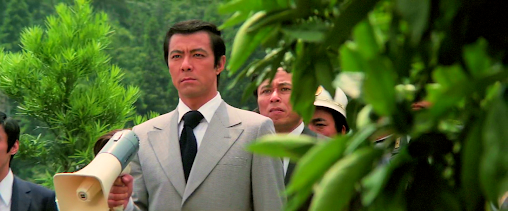
Star Jiro Tamiya was aMasumura favourite who had previously featured in the latter’s Black Super-Express (1964), which alsohad a plot revolving around the shinkansen.His co-star, Masaomi Kondo, had been around for a while, having debuted in ShoheiImamura’s The Pornographers (1966),but was mostly known for his TV work at this point, and the part of Akiyamamarked his biggest film role to date. The rest of the cast features somewell-known faces – including Meiko Kaji as a barmaid who falls for Akiyama andSo Yamamura as the president of JNR – but the characters are generally on thethin side and don’t give the actors many opportunities to impress. Not that itmatters much – the film rattles along at high speed much like the trains itfeatures, and there’s also a pretty decent score by Hikaru Hayashi, who oftenworked with Kaneto Shindo as well as Masumura.
Toei released thesimilarly-themed Shinkansen daibakuhaaka Bullet Train the same year.
Note on the title: The film is sometimes referredto in English as Dynamic Islands, but a more accuratetranslation of theJapanese title is ‘Artery Archipelago’, which would make sense if one added ‘ofthe’ in the middle.
June 2, 2025
Hachi hyakuman goku ni idomu otoko / 八百万石に挑む男 (‘The Man Who Made an 8 Million koku Challenge’, 1961)
Obscure Japanese Film #191
 Utaemon Ichikawa and Katsuo Nakamura
Utaemon Ichikawa and Katsuo Nakamura
1729. Ten’ichibo(Katsuo Nakamura, brother of Kinnosuke Nakamura) is a young man who drifts fromtown to town gambling and drinking. He carries an antique dagger and letterexplaining that the knife is an heirloom given to him as he is the illegitimateson of the eighth shogun, Yoshimune Tokugawa (Shin Tokudaiji), but nobodybelieves him and Ten’ichibo himself is uncertain of the truth. However, boththe letter and the weapon look authentic and when the story comes to theattention of once-powerful samurai vassal Iganosuke (Utaemon Ichikawa), hecares little whether it’s true or not, but sees an opportunity to take over theshogunate by claiming Ten’ichibo as the rightful heir. It’s a high stakesgamble which could cost Ten’ichibo and Iganosuke their lives if they fail, butwin them 8 million koku if theysucceed (koku being a unit ofmeasurement of rice, which was how wealth was calculated at the time). Theshogun’s advisor, Matsudaira (So Yamamura), is also unconcerned about the truthof Ten’ichibo’s parentage, but wants to discredit him anyway to retain thepower of the current regime…
Inspired by a realhistorical event and based on an original screenplay by regular Kurosawacollaborator Shinobu Hashimoto, this Toei production was directed by NobuoNakagawa, best remembered today for horror movies such as The Ghost of Yotsuya (1959), though the genre accounted for onlyeight out of his nearly 100 films. Many of his pictures tended to be quite lowbudget, but this one looks comparatively expensive, boasting elaborate costumesand impressive sets. Typically for a Hashimoto script, it’s full of cruelironies and highlights the hypocrisy of the feudal system.
Most (if not all) ofthe cast had theatre backgrounds, and the acting is rather stagey, with many ofthe actors projecting their voices as if worried about not being heard in theback row. Given the formal context of most of thedialogues, the stiffness of some cast members is perhaps inevitable, but I’mnot sure there’s much excuse for Utaemon Ichikawa, who – with his demoniacallaugh – is such an old ham he’d make Tod Slaughter blush. It’s also a verymale-dominated movie, and the one female character (played by HirokoSakuramachi) has very little to do except be a victim. Fans of chanbara (sword-fighting films) shouldbe warned that there is very little action (with the climax even taking placeoff screen), but, on a more positive note, the battle of wills between the twosides is tense enough to hold the interest for the most part, and there’s a finescore by Chumei Watanabe.
The story of the Ten’ichibojiken, or ‘incident’ (as it is oftenreferred to in Japan), has been filmed many times – there were numerous silentversions (now lost) as well as various TV versions made subsequent to thisfilm. However, the most notable other feature film version is Daisuke Ito’s Suronin makaritoru (1947), the firstperiod drama made after the war, starring Tsumasaburo Bando as Iganosuke andAkihiko Katayama as Ten’ichibo, which is available on DVD (without Englishsubtitles) here. The real Ten’ichibo was arrested, charged with being animposter, sentenced to death and executed.
Thanks to A.K.
May 26, 2025
Onna no saka / 女の坂 (‘A Woman’s Uphill Struggle’, 1960)
Obscure Japanese Film #190
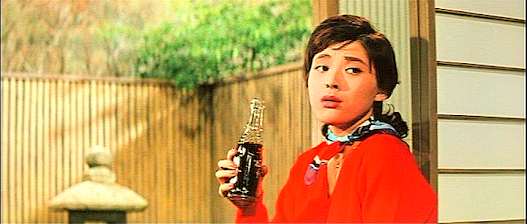 Mariko Okada
Mariko Okada
After one of her uncles dies, Akie (Mariko Okada), a spirited youngwoman from Hakone, inherits his confectionary business in Kyoto. The company, Kagimura,is famous for an agar-based sweet called Kyoshigure, but the master confectioner, Taniji (Minpei Tomimoto), is the onlyone who knows how to prepare it properly and he’s in prison after accidentallykilling an employee in a fight (which, oddly, nobody seems too bothered about).Akie originally intends to turn the premises into a dressmaking businessinstead, but when Tajiji is released, he makes Kyo shigure for her and she’s so impressed that she decides torevive her late uncle’s business.
One day, Akie’s mother, Keiko (Nobuko Otowa), arrives with acompanion, Yaoi (Keiji Sada). He’s a woodblock artist who has come to Kyoto to sketchsome maiko (apprentice geisha), and Keikohas suggested that he stay with Akie instead of at an inn as she has plenty ofspace. Akie and Yaoi fall in love, but he’s already married with two children –and what exactly is the nature of his relationship with Keiko?
Like the previously-reviewed WeddingDay, Sweet Secret and Ai sureba koso, this was distributed byShochiku but produced by Kindai Eiga Kyokai, an independent company formed in1950 by director Kozaburo Yoshimura, screenwriter Kaneto Shindo and TaijiTonoyama, the latter of whom appears here as one of Akie’s uncles. The storywas cobbled together from two novels by Hisao Sawano (1912-92), both of whichwere published the same year the film was released. Sawano was best-known forhis novel River of the Night, filmedby Yoshimura in 1956.
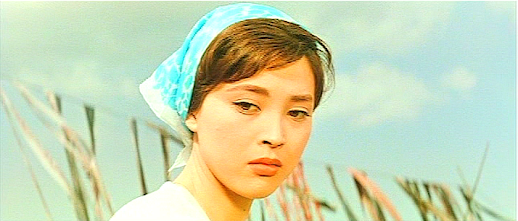
For the first hour, the film is as light and insubstantial as a soufflé,and appears to be a simple rom-com made as a vehicle for Mariko Okada, whoundergoes innumerable costume and hairstyle changes and whose charm the picturerelies heavily upon. However, the tone eventually becomes more serious, eventhrowing in a suicide that seemed to me entirely superfluous. The message ofthe movie is very clear by the end, but it’s also a rather simple andconservative one, basically implying that one should not break the conventionalrules of society as there are good reasons for them and the best thing to do ifdisappointed in love is repress your feelings and work, work, work!
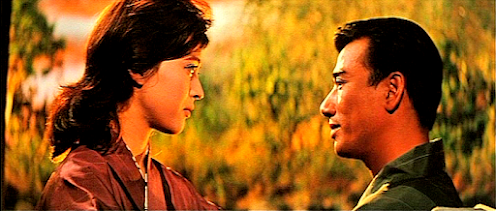
In my view, this is a minor effort from director KozaburoYoshimura, though it’s not without interest. For no good reason, it throws inGanjiro Nakamura as an avant-garde potter, and there’s a surprisingly sensualmoment when Akie sucks the pipe smoke from Yaoi’s mouth, while Toshiro Mayuzumi’sscore is inventive and steers admirably clear of cliché. On the whole, though, Onna no saka is likely to be bestenjoyed by fans of Mariko Okada.
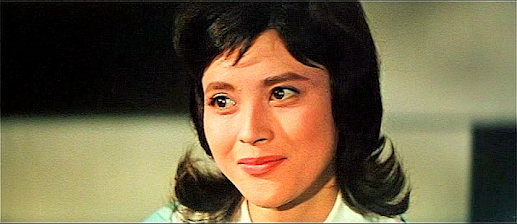
Bonus trivia: Kyo shigureappears to be a genuine dessert, although I have no idea whether it was createdbefore or after the film existed, or even especially created for it. Those witha sweet tooth can find out more here (in Japanese).
